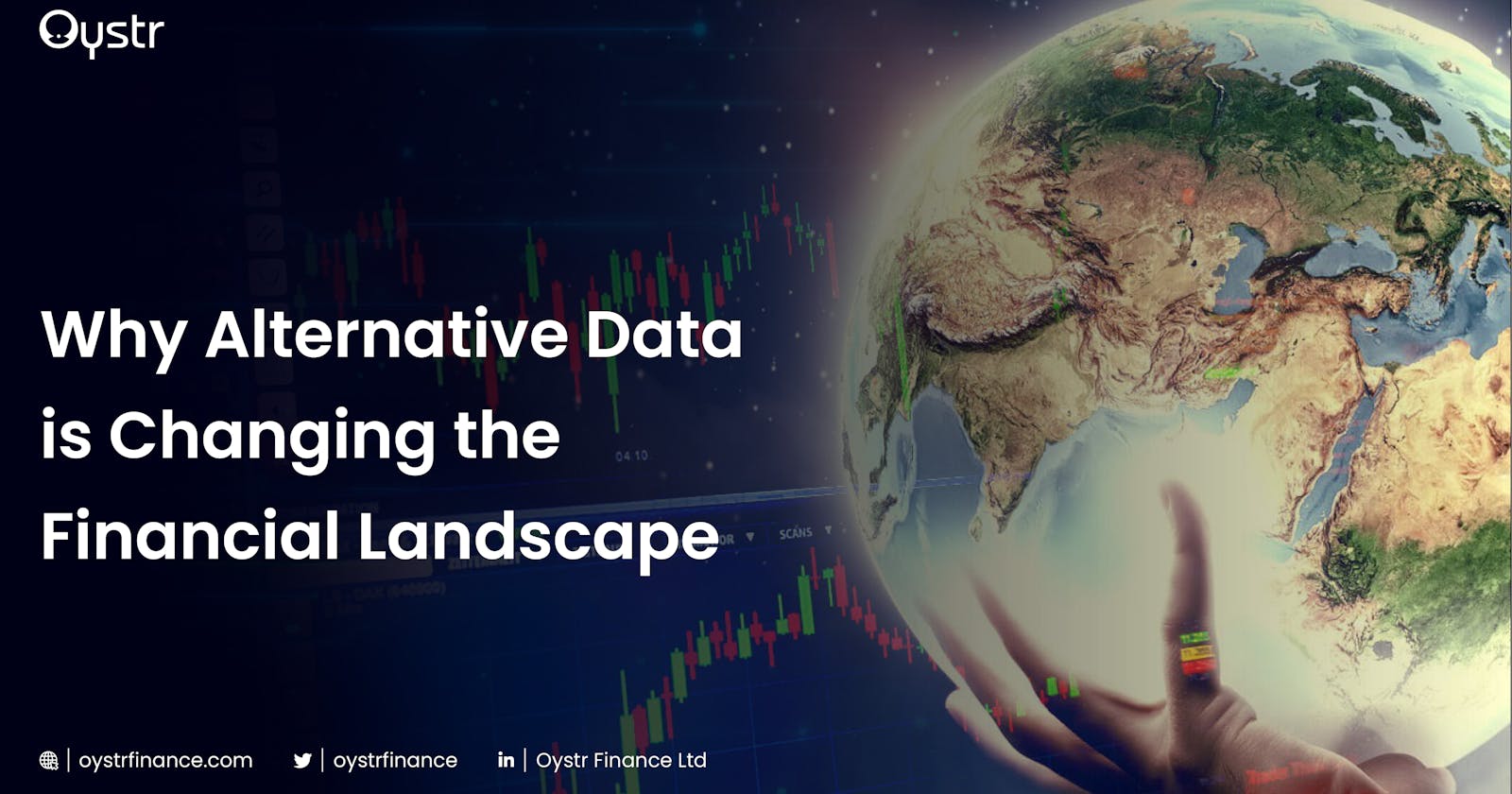The Finance Industry generates and utilizes a lot of data. Traditional datasets (SEC filings, broker forecasts, financial statements, management presentations, press releases etc.) previously informed decisions in the industry. However, digitizing the financial landscape and the world became an eye-opener to several companies and institutions.
Technological advancement and adoption birthed an era of rapid and massive data generation from advanced computational capacity and digital usage. The consequential digitization of the finance industry creates a need for faster, more accurate insights and metrics than traditional data sources. The digital economy generates volumes of data with millions of valuable insights buried deep within.
Alternative data offers access to real-time information in big data pockets that translate into financial insights. The ability to transform data into quants of actionable intelligence makes alternative data attractive in the financial landscape. Key players in the industry are readily exploiting this disruptor to step up their game in the financial markets.
What Is Alternative Data?
In finance, alternative data refers to information accessible through digitized datasets but is compiled from non-traditional sources and used to inform financial decisions. These unconventional datasets include financial and non-financial information accumulated from financial transactions, sensors, mobile devices, satellites, public records, and the internet. Consequently, examples range from credit card transactions, email receipts, and point-of-sale transactions to geolocation or foot traffic data, satellite images, website usage, mobile app usage, online browsing activity, incomplete records, product reviews, price trackers, and social media posts.
How Is Alternative Data Transforming Finance?
Here are a few ways alternative data is changing the world of finance.

Exposing Hidden Figures
Valuable information is often hidden in plain sight. Alternative data combined with machine learning and AI makes exposing and mining such hidden figures easier. Moreover, alternative data reveals previously hidden figures and signals that give a competitive advantage, especially in combination with traditional financial data. For instance, companies often downplay certain information needed to make well-informed decisions. However, alternative data provides a unique view and reveals hidden facts beyond what traditional data such as SEC filings and financial disclosures offer.
Driving Financial Inclusion
Alternative data allows financial institutions to extend their financial services and products to the unbanked, thereby driving financial inclusion .
The traditional credit framework excludes individuals without the credit history required for risk assessment from the mainstream financial system. As a result, millions of Africans lack access to formal credit. However, with alternative data, financial institutions can offer instant loans to applicants with an alternative credit score. Beyond credit scoring, several traditional bank transactions require arduous tasks of providing some information that unbanked individuals are unable to deliver. However, alternative data allows extracting relevant information from unconventional sources to ensure the underserved access to essential financial services.
Disrupting Traditional Banking
Banks make better-informed decisions when they use alternative data. FinTech competitors increasingly and proactively leverage alternative data for business expansion. As a result, traditional banks are forced into a struggle for relevance, shifting them towards alternative data. They can identify critical areas within the banking sector and new markets to penetrate with alternative data.
Predictive Decision-Making
Through advanced analytics, insights from alternative data become strategizing and decision-making tools. As a result, a company or institution harnesses the power of data-driven decisions and places itself on the threshold of success in any industry.
Alternative data has transformed financial decision-making. Institutions are not just making data-driven decisions but also sound forecasts and predictions. Proper analytics of alternative data extracts insights relevant to a particular company and avail them for making predictions. For instance, financial performance in a new market can be predicted by modelling alternative data from a previous call.
Furthermore, predictive decision-making allows financial analysts to include various factors that could influence and cause transitions in the market. This helps their organizations prepare ahead and gain a competitive advantage. Hence, several hedge funds and investment firms employ alternative data and analysts to help them generate alpha and compete favourably in the market.
Applications of Alternative Data in Finance
In the financial space, alternative data is used for the following;
Investment Research and Deal Sourcing
Deal sourcing (or finding profitable, low-risk deals) require serious research. Hedge fund managers and private equity firms leverage alternative data in their research. It helps them identify trends and guides them to make more strategic investment decisions. Alternative data analytics provides valuable insights that inform decision-making and help find and chase the best deals. Integrating alternative data insights into investment research provides remarkable and timely insights into investment opportunities.

Demand Forecasting
Alternative data helps analysts to predict economic trends and market demand for certain services and products. Investment companies use insights from alternative data to build predictive models for demand. These models predict the performance of certain investments and make informed investment decisions. Based on insights from alternative data, analysts trace correlations between events and performances to predict consumer demand and response.
Risk Management
Institutions that offer financial services and products carry out a risk assessment as an essential part of their operation. Alternative data provides datasets that inform risk assessment and help organizations avoid bad risks. Analysts extract risk indicators from unique datasets such as adverse media, sanctions, PEPs, and company financial indicators. Using alternative data as additional indicators reinforces risk assessment and guides organizations to accurately measure, manage and mitigate risk.
Portfolio Management
Asset managers and investment companies endeavour to be foresighted and long-term oriented in their operations. Nonetheless, alternative data helps monitor the market and recognize the best timing for action. They identify when it’s time to accumulate and hold more assets and sell or offload assets.
Financial Identity
Alternative data provides information on underserved individuals to financial institutions and helps them access desired services. For instance, FiDaaS (Financial Identity as a Service) uses alternative data from mobile phone usage and broadband access to create identities for unbanked and underbanked individuals.
They make and provide information to financial institutions, e.g. credit scores, for individuals without a formal credit history to access loans. Individuals interact daily on their mobile phones, simultaneously generating loads of data. Rich, contextual understanding of individuals built from alternative data enables more accurate risk assessment and personalized customer experiences. This reduces financial/credit institutions’ traditional dependence on previous credit behaviour to determine or predict a customer’s future behaviour.
Customer Relationship
Alternative data gives more accurate and valuable customer insights than traditional data sets. It helps firms accurately profile their customers, address what is important to them, and improve customer relationships. Alternative data such as web traffic and app usage provide insight into consumer buying, bidding, and selling behaviours. Online reviews and social media engagement contain insights into customer needs, experiences, and expectations. This helps institutions better understand customer behaviour, manage customer relationships, and make competitive strategies and decisions.
What Makes Alternative Data So Powerful in the Financial Landscape?
Alternative data is rapidly changing the financial ecosystem. Increasing numbers of financial institutions embrace these unconventional datasets as their choice for obtaining insights to make financial decisions. Below are three elements that make alternative data so attractive in Finance.

Real-Time Information
The importance of updated data in finance cannot be over-emphasized. Alternative data allows financial institutions to relate and measure information in real-time. This results in the generation of innovative pointers that give a competitive advantage. Alternative data technologies permit real-time analysis of market performance.
For instance, investors could predict industry trends, KPIs and market shifts by tracking daily data as consumer behaviour shifted during the COVID-19 pandemic. Analysts dependent on traditional market research and reports took longer to understand the influence of those shifts on financial markets.
Larger and Dynamic Datasets
Alternative data provides access to a wealth of robust, wide-ranging datasets. Experienced hedge funds, venture capital and private equity firms incline toward using multiple datasets and sources to carry out modelling and due diligence. Alternative data is compiled from various sources such as financial transactions, sensors, mobile devices, satellites, public records, and the internet.
Hence, it provides an extra and unique perspective and insights. In the past, having to process millions of records to tens of billions, sometimes trillions of records, would be impossible. However, the inception of powerful cloud infrastructure and the development of dynamic data analysis tools such as Tableau, Pandas, R, etc., empower analysts to transform large data sets into relevant information that informs tactical financial decisions.
Ease of Acquiring Data
The ease of acquiring such large quantities of information makes alternative data attractive in finance. As a result, several alternative data sources have been identified in the last two decades, and financial data has become easier to obtain. Today, over 400 providers supply alternative data in the marketplace. These platforms aggregate, extract, vet, and sometimes even translate to insight-ready, alternative data from different sources.
Many alternative data platforms do more than data sourcing. These platforms run programs with the capacity to seamlessly and rapidly consume and onboard any size, volume, number or structure of raw data from new data sources. They also allow the refining and deployment of new use cases and facilitate analysis and real-time tracking. Data governance ensures that alternative data providers provide their clients with secure data.
Conclusion
The Financial landscape is transitioning into a fast-paced, digital ecosystem. Access to vast, accurate, up-to-date information helps financial actors, especially investment and wealth management institutions, to make insightful and foresighted decisions. Moreover, alternative data offers a well of information that can be exploited by leveraging big data analytics, machine learning and AI. It means access to real-time information for cutting-edge strategic planning and decision-making. In response, financial institutions and FinTech firms join the unconventional data train for dominance in the financial markets.
Partnering with Oystr finance, an alternative data infrastructure in Africa will be beneficial to financial operators. Ready to join the financial evolution? Visit our website

